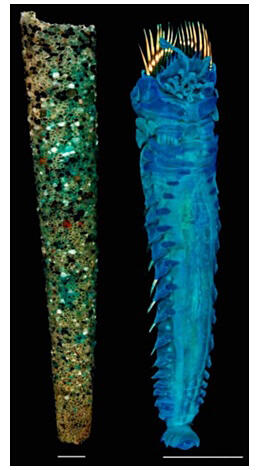A research group comprising Professor Eijiroh Nishi of Yokohama National University (YNU), Curator Shinri Tomioka of Rishiri Town Museum, Lecturer Dr. Naoto Jimi of Nagoya University, and Principal Researcher Yoshihiro Fujiwara of the Research Institute for Global Change, at the Japan Agency for Marine-Earth Science and Technology has discovered a new species of 'ice-cream cone worms' (Polychaeta, Pectinariidae) on the sandy mud sea bottom at a depth of approximately 1,200 m off the coast of Kushiro, Hokkaido. Its scientific name is Amphictene hokkaido sp. nov., and is called Ezo-umi-isagomushi in Japanese. This important discovery will lead to clarification of the biodiversity on the deep-sea floor of Japan, and new records and discoveries of novel species in the deep sea are expected in the future. The results have been published in Plankton and Benthos Research.

Provided by Yokohama National University
The "isago-mushi" are freshwater insect worms which belong to the family Trichoptera. The Japanese word "isago" is one way of reading the character "sand (砂)," and so the novel species was named after the grains of sand that harden into the elongated cylindrical, conical, or horn-shaped tubes that they inhabit.
The Pectinariidae, "umi-isago-mushi" live in the sea (=umi) and form habitat tubes similar to those of the "isago-mushi" but because they are members of Annelida, such as the lugworm, their bodies resemble thick, short worms with fine hairs. In English speaking countries, these animals are known as "ice-cream cone worms" or "trumpet worms" because of the unique shape of their nests (habitat tubes). The elongated tube is open at both ends, being broad at the head (anterior) and gradually tapering toward the tail (posterior). The worm body is similarly shaped, with characteristic spiny needles on the head, gills, and tentacles. When alive, the worm feeds by burrowing its head into the sandy mud.
Generally, Pectinariidae individuals are approximately 1-5 cm long, whereas their tube is approximately 2-10 cm in length. To date, approximately 60 species in five genera have been identified from the world's oceans, and nine species in four genera have been recorded in Japan.
The species discovered in the deep sea off the coast of Kushiro is the 10th one of the Pectinariidae, the 2nd of the Amphictene from Japan, and the 18th of the Amphictene from around the world. Specimens range approximately 25-40 mm in length, with a body width of 5-6 mm at the head and approximately 3 mm at the tail.
The body of the worm is light brown. Its tube is elongated and cylindrical, broad at the front, and narrow at the tail, and was estimated to be 35-50 mm in length, 6-8 mm wide at the anterior opening, and 2-3 mm wide at the posterior opening. However, because the posterior opening was damaged, the exact length and width could not be measured.
Although Amphictene japonica (Nilsson, 1928) (Nihon-umi-isagomushi) is recorded to be from the waters around Japan and Amphictene moorei from the northern waters of Hokkaido, they differ in the glandular zone on the ventral side of the anterior part of the body, the morphology of the vertebral foot on the posterior half of the body, and the bristly hairs. A record of Amphictene japonica from the deep-sea floor on the Pacific side of Honshu exists, but the specimen needs to be re-examined, including the possibility that it is actually Amphictene hokkaido sp. nov.
The new species was collected in October 1997 off the coast of Kushiro by the oceanographic research vessel "Kaiyo," which lowered its survey system Deep Tow to the bottom of the sandy mud at a depth of 1,160 m.
Journal Information
Publication: Plankton and Benthos Research
Title: A new species of Amphictene (Annelida, Polychaeta, Pectinariidae) from off Kushiro, Hokkaido, Japan
DOI: 10.3800/pbr.19.51
This article has been translated by JST with permission from The Science News Ltd. (https://sci-news.co.jp/). Unauthorized reproduction of the article and photographs is prohibited.




